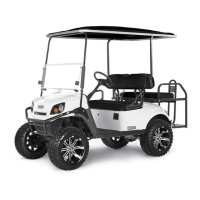OPERATION
21
OPERATION
SAFETY
Failure to operate the vehicle correctly can result in a collision, loss of control, accident
or rollover, and cause serious injury or death. Follow all operation procedures in this
section of the manual. Read and comply with all safety warnings in the safety section of
this owner’s manual.
BEFORE INITIAL USE
To prepare the new vehicle for operation, complete the following:
• Remove the protective plastic from the seats.
• Check for possible leaks that may have developed during shipment of the vehicle.
Explosive hydrogen gas is created during the charge cycle of the batteries. Proper venti-
lation is necessary to remove the gas from enclosed spaces. The air must change every
12 minutes.
Never charge a vehicle near flammable materials, open flames, or sparks. Never charge a
vehicle near gas water heaters or furnaces.
• Charge batteries.
• Perform the following pre-ride inspection.
PRE-RIDE INSPECTION
Inspect and verify that the vehicle is in safe operating condition before each use to decrease the risk of an accident.
Check the items in the table to help ensure safe and reliable operation.
Item Check Page
Batteries Check charge level
Brake system/pedal travel Check for proper operation. 38
Parking brake Ensure vehicle does not roll when the parking brake is engaged.
Front suspension Inspect. Lubricate if necessary. Check for loose or missing hardware.
Rear suspension Inspect. Lubricate if necessary. Check for loose or missing hardware.
Steering Check for smooth and free operation.
Tires Check condition and pressure. 33
Wheel hardware Check for loose or missing hardware.
Frame hardware Check for loose or missing hardware.
Fluid leakage Inspect vehicle for leaks.
Switches Check operation.
Reverse warning alarm Check operation.
Headlights Check operation. 35
Brake light / taillights Check operation. 35

